The Armor of the Chinese Sturgeon: A Study of the Microstructure and Mechanical Properties of the Ventral Bony Plates
Abstract
:1. Introduction
2. Materials and Methods
2.1. Materials and Experiments
2.2. SEM and EDX Analysis
2.3. Nanoindentation Experiments
2.4. Tension/Compression Tests
3. Results
3.1. Arrangement Feature
3.2. Microstructural Characterization
3.3. Component Analysis
3.4. Nanoindentation Tests
3.5. Tensile Responses
3.6. Compression Properties
4. Discussion
5. Conclusions
- (1)
- The ventral bony plates possessed a ridge-like structure with serrated edges. There were numerous nodular ridges on the surface of the bony plates with a height of 200–300 μm. These nodular ridges enhanced the connectivity between the bony plates and the fish skin epidermis. The bony plates featured a hierarchical structure with a thickness of approximately 300 μm that was composed of highly mineralized nanocrystals and highly mineralized collagen fibers.
- (2)
- The bony plates were primarily composed of HAP. Along the surface layer to the internal layer of the bony plates, the Ca, P, and O contents gradually decreased, while the C content increased. This indicates that the mineralization degree of the internal layer decreased while the content of organic tissues such as mineralized collagen fibers increased. The composition analysis results were consistent with the microscopic morphological observations. The presence of fibrous tissues significantly improved the fracture mechanical properties of the bony plates.
- (3)
- The results of nanoindentation tests revealed that the elastic modulus and hardness of the bony plates decreased gradually from the surface layer to the internal layer. Compared with the wet samples, the elastic modulus and hardness of the dry samples were 38.32% and 40.01% higher, respectively. It is readily apparent that the presence of water significantly reduced the elastic modulus and hardness of the bony plates. However, the indentation microstructure also indicated that water effectively improved the elastic strain and toughness of the bony plates and delayed crack initiation and propagation, thereby greatly enhancing the fracture resistance of the structures.
- (4)
- The results of tension tests demonstrated that the bony plates had obvious anisotropic characteristics. The tensile strengths of the dry and wet specimens were 136.23 ± 3.57 and 139.47 ± 4.26 MPa in the longitudinal direction and 98.62 ± 3.43 and 100.57 ± 3.51 Mpa in the transverse direction, respectively. For the dry and wet samples, the tensile strengths in the longitudinal direction were 38.14% and 38.68% higher, respectively, than those in the transverse direction. In addition, water had no effect on the tensile strength of the bony plates, although it effectively improved the viscoelasticity and ductility of the structures and enabled easier sliding and rotation of the collagen fibers, thus improving the plasticity of the bony plates.
- (5)
- The results of compression tests revealed that the compression force for the wet samples was increased by 64.71% compared with the dry samples. Although the dry samples displayed superior elastic modulus, hardness, and deformation resistance, fracture failure occurred prematurely during the tests owing to the obvious brittleness of these samples. By contrast, the wet specimens exhibited good elastic strain and toughness and could fully exploit the deformation characteristics of the bony plates. Thus, the wet bony plates afforded superior protective performance by effectively balancing strength, hardness, and toughness, which could provide unique guidance and insights for the design of lightweight protective structures.
Author Contributions
Funding
Institutional Review Board Statement
Data Availability Statement
Conflicts of Interest
References
- Zhang, C.; Rawat, P.; Liu, P. A new design and performance optimization of bio-inspired flexible protective equipment. Bioinspir. Biomim. 2020, 15, 066003. [Google Scholar] [CrossRef] [PubMed]
- Quan, H.; Yang, W.; Schaible, E. Novel defense mechanisms in the armor of the scales of the “Living Fossil” coelacanth fish. Adv. Funct. Mater. 2018, 28, 1804237. [Google Scholar] [CrossRef]
- Zhu, D.; Zhang, C.; Liu, P. Comparison of the morphology, structures and mechanical properties of teleost fish scales collected from New Zealand. J. Bionic Eng. 2019, 16, 328–336. [Google Scholar] [CrossRef]
- Liu, Z.; Meyers, M.A.; Zhang, Z. Functional gradients and heterogeneities in biological materials: Design principles, functions, and bioinspired applications. Prog. Mater. Sci. 2017, 88, 467–498. [Google Scholar] [CrossRef]
- Rawat, P.; Zhu, D.; Rahman, M.Z. Structural and mechanical properties of fish scales for the bio-inspired design of flexible body armors: A review. Acta Biomater. 2021, 121, 41–67. [Google Scholar] [CrossRef]
- Porter, M.M.; Ravikumar, N.; Barthelat, F. 3D-printing and mechanics of bio-inspired articulated and multi-material structures. J. Mech. Behav. Biomed. 2017, 73, 114–126. [Google Scholar] [CrossRef]
- Sherman, V.R.; Quan, H.; Yang, W. A comparative study of piscine defense: The scales of Arapaima gigas, Latimeria chalumnae and Atractosteus spatula. J. Mech. Behav. Biomed. 2017, 73, 1–16. [Google Scholar] [CrossRef]
- Zhu, D.; Szewciw, L.; Vernerey, F.; Barthelat, F. Puncture resistance of the scaled skin from striped bass: Collective mechanisms and inspiration for new flexible armor designs. J. Mech. Behav. Biomed. 2013, 24, 30–40. [Google Scholar] [CrossRef] [PubMed]
- Murcia, S.; Lavoie, E.; Linley, T.; Devaraj, A.; Ossa, E.A.; Arola, D. The natural armors of fish: A comparison of the lamination pattern and structure of scales. J. Mech. Behav. Biomed. 2017, 73, 17–27. [Google Scholar] [CrossRef]
- Fang, Z.; Wang, Y.K.; Feng, Q.; Kienzle, A.; Müller, W.E.G. Hierarchical structure and cytocompatibility of fish scales from Carassius auratus. Mat. Sci. Eng. C-Mater. 2014, 43, 145–152. [Google Scholar] [CrossRef]
- Yu, M.; Liu, H.R.; Liu, J.H.; Li, S.M. Unique structure and mechanical property of Dabryanus scale. J. Bionic Eng. 2016, 13, 641–649. [Google Scholar] [CrossRef]
- Yang, W.; Gludovatz, B.; Zimmermann, E.A.; Bale, H.A.; Ritchie, R.O.; Meyers, M.A. Structure and fracture resistance of alligator gar (Atractosteus spatula) armored fish scales. Acta Biomater. 2013, 9, 5876–5889. [Google Scholar] [CrossRef] [PubMed]
- Bruet, B.J.F.; Song, J.H.; Boyce, M.C.; Ortiz, C. Materials design principles of ancient fish armor. Nat. Mater. 2008, 7, 748–756. [Google Scholar] [CrossRef] [PubMed]
- Munther, M.; Palma, T.; Angeron, I. Microfabricated Biomimetic placoid scale-inspired surfaces for antifouling applications. Appl. Surf. Sci. 2018, 453, 166–172. [Google Scholar] [CrossRef]
- Wang, J.; Lan, S.L.; Guang, C. Experimental study on the turbulent boundary layer flow over riblets surface. Fluid Dyn. Res. 2000, 27, 217–229. [Google Scholar] [CrossRef]
- Song, J.; Reichert, S.; Kallai, I.; Dan, G.; Wund, M.; Boyce, M.C.; Ortiz, C. Quantitative microstructural studies of the armor of the marine threespine stickleback (Gasterosteus aculeatus). J. Struct. Biol. 2010, 171, 318–331. [Google Scholar] [CrossRef]
- Chua, Y.S.; Law, E.; Pang, S.D.; Quek, S.T. Fish scale-cellular composite system for protection against low-velocity impact. Compos. Struct. 2016, 145, 217–225. [Google Scholar] [CrossRef]
- Chua, Y.S.; Law, E.; Pang, S.D.; Quek, S. Impact behaviour and design optimization of a ductile scale-cellular composite structure for protection against localized impact. Int. J. Solids Struct. 2017, 122, 162–174. [Google Scholar] [CrossRef]
- Vernerey, F.J.; Barthelat, F. Skin and scales of teleost fish: Simple structure but high performance and multiple functions. J. Mech. Phys. Solids 2014, 68, 66–76. [Google Scholar] [CrossRef]
- Ma, J.; Zhuang, P.; Kynard, B.; Zhang, T.; Zhang, L.Z. Morphological and osteological development during early ontogeny of Chinese sturgeons (Acipenser sinensis gray, 1835). J. Appl. Ichthyol. 2014, 30, 1212–1215. [Google Scholar] [CrossRef]
- Wang, C.Y.; Wei, Q.W.; Kynard, B.; Du, H.; Zhang, H. Migration and movements of adult Chinese sturgeon Acipenser sinensis in the Yangtze River, China. J. Fish. Biol. 2012, 81, 696–713. [Google Scholar] [CrossRef] [PubMed]
- Ye, H.; Li, C.J.; Yue, H.M.; Du, H.; Yang, X.G.; Yoshino, T.; Wei, Q.W. Establishment of intraperitoneal germ cell transplantation for critically endangered Chinese sturgeon Acipenser sinensis. Theriogenology 2017, 94, 37–47. [Google Scholar] [CrossRef] [PubMed]
- Huang, Z.L.; Wang, L.H. Yangtze dams increasingly threaten the survival of the Chinese sturgeon. Curr. Biol. 2018, 28, 3640–3647. [Google Scholar] [CrossRef] [PubMed]
- Wu, C.; Chen, L.; Gao, Y.; Jiang, W. Seaward migration behavior of juvenile second filial generation Chinese sturgeon Acipenser sinensis in the Yangtze River, China. Fish. Sci. 2018, 84, 71–78. [Google Scholar] [CrossRef]
- Hilton, E.J.; Dillman, C.B.; Zhang, T.; Zhang, L.Z.; Zhuang, P. The skull of the Chinese sturgeon Acipenser sinensis (Acipenseridae). Acta Zool.-Stockh. 2016, 97, 419–432. [Google Scholar] [CrossRef]
- Xiao, K.; Du, H.; Hu, Y.; Liu, X.; Yao, J. A pioneering approach for non-invasive sex identification of Chinese sturgeon at early stage. Aquaculture 2021, 538, 736530. [Google Scholar] [CrossRef]
- Li, Y.; Lin, J.; Liu, Y.; Yao, W.; Zhang, D.; Peng, Q.; Qian, S. Refined operation of cascade reservoirs considering fish ecological demand. J. Hydrol. 2022, 607, 127559. [Google Scholar] [CrossRef]
- Zheng, Y.; Guo, C.; Li, L.H.; Ma, Y.P. Morphology and mechanical properties of the dorsal bony plates in the Chinese sturgeon (Acipenser sinensis). Microsc. Res. Tech. 2019, 82, 1083–1091. [Google Scholar] [CrossRef]
- Bechert, D.W.; Bruse, M.; Hage, W. Experiments with three-dimensional riblets as an idealized model of shark skin. Exp. Fluids 2000, 28, 403–412. [Google Scholar] [CrossRef]
- Li, L.; Guo, C.; Li, X.; Xu, S.; Han, C. Microstructure and mechanical properties of rostrum in Cyrtotrachelus longimanus (Coleoptera: Curculionidae). Anim. Cells Syst. 2017, 21, 199–206. [Google Scholar] [CrossRef] [Green Version]
- Allison, P.G.; Chandler, M.Q.; Rodriguez, R.I.; Williams, B.A.; Moser, R.D.; Weiss, C.A.; Poda, A.R.; Lafferty, B.J.; Kennedy, A.J.; Seiter, J.M.; et al. Mechanical properties and structure of the biological multilayered material system, Atractosteus spatula scales. Acta Biomater. 2013, 9, 5289–5296. [Google Scholar] [CrossRef]
- Allison, P.G.; Rodriguez, R.I.; Moser, R.D.; Williams, B.A.; Poda, A.R.; Seiter, J.M.; Lafferty, B.J.; Kennedy, A.J.; Chandler, M.Q. Characterization of multi-layered fish scales (Atractosteus spatula) using nanoindentation. J. Vis. Exp. 2014, 89, 51535. [Google Scholar]
- Wang, B.; Meyers, M.A. Seagull feather shaft: Correlation between structure and mechanical response. Acta Biomater. 2017, 48, 270–288. [Google Scholar] [CrossRef] [PubMed]
- Song, J.H.; Ortiz, C.; Boyce, M.C. Threat-protection mechanics of an armored fish. J. Mech. Behav. Biomed. 2011, 4, 699–712. [Google Scholar] [CrossRef] [PubMed]
- Franke, O.; Durst, K.; Maier, V.; Birkholz, T.; Schneider, H. Mechanical properties of hyaline and repair cartilage studied by nanoindentation. Acta Biomater. 2007, 3, 873–881. [Google Scholar] [CrossRef]
- Guidoni, G.; Swain, M.; Jäger, I. Nanoindentation of wet and dry compact bone: Influence of environment and indenter tip geometry on the indentation modulus. Philos. Mag. 2010, 90, 553–565. [Google Scholar] [CrossRef] [Green Version]
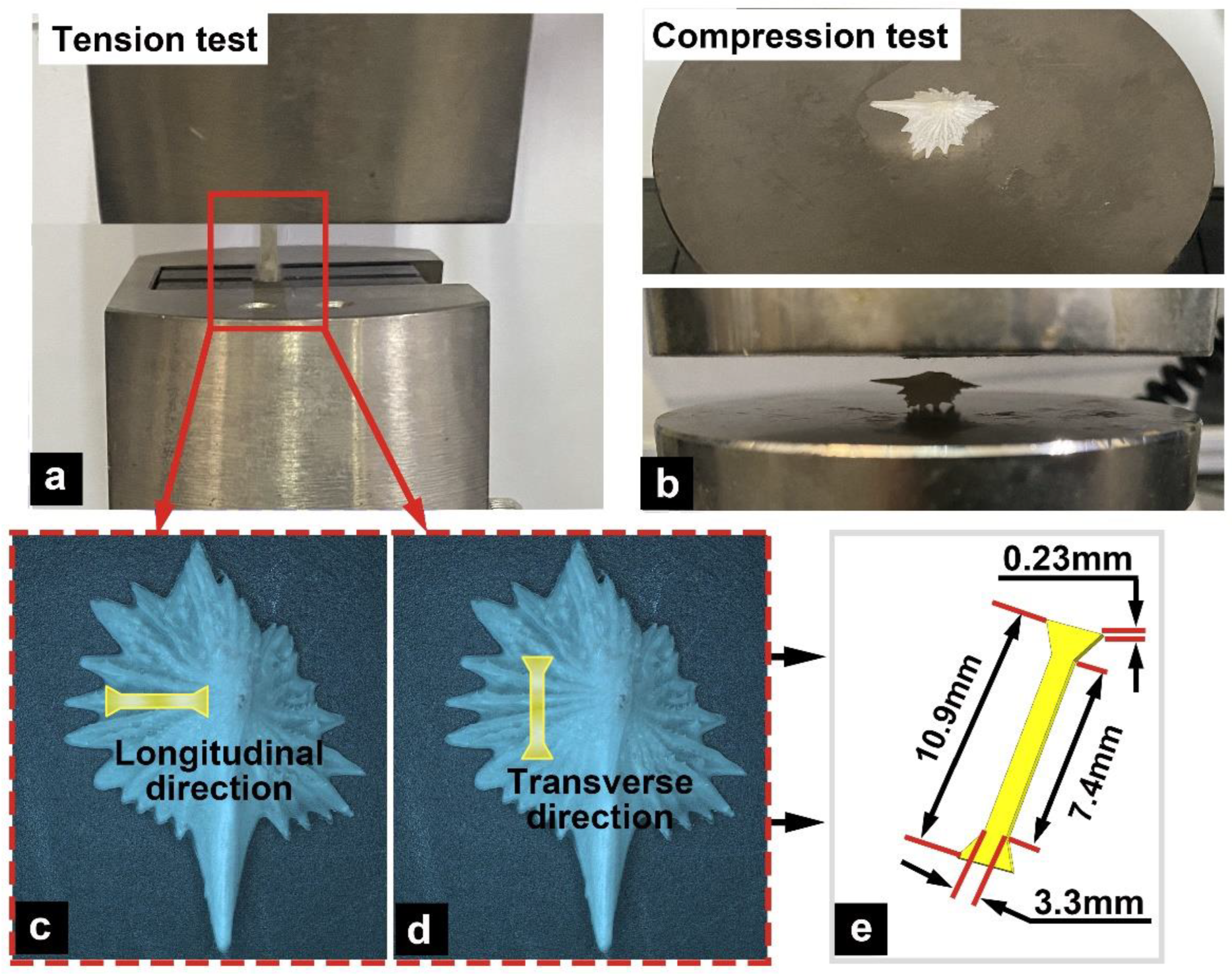
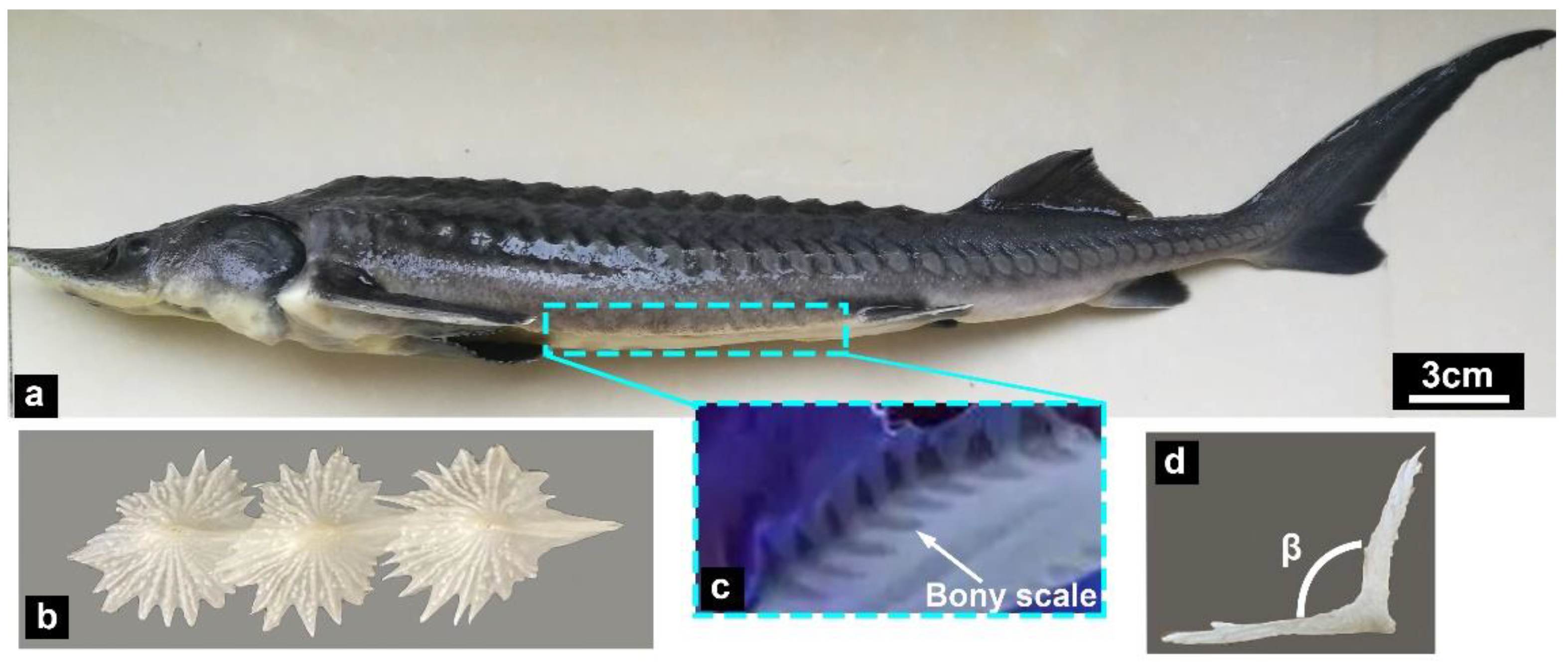
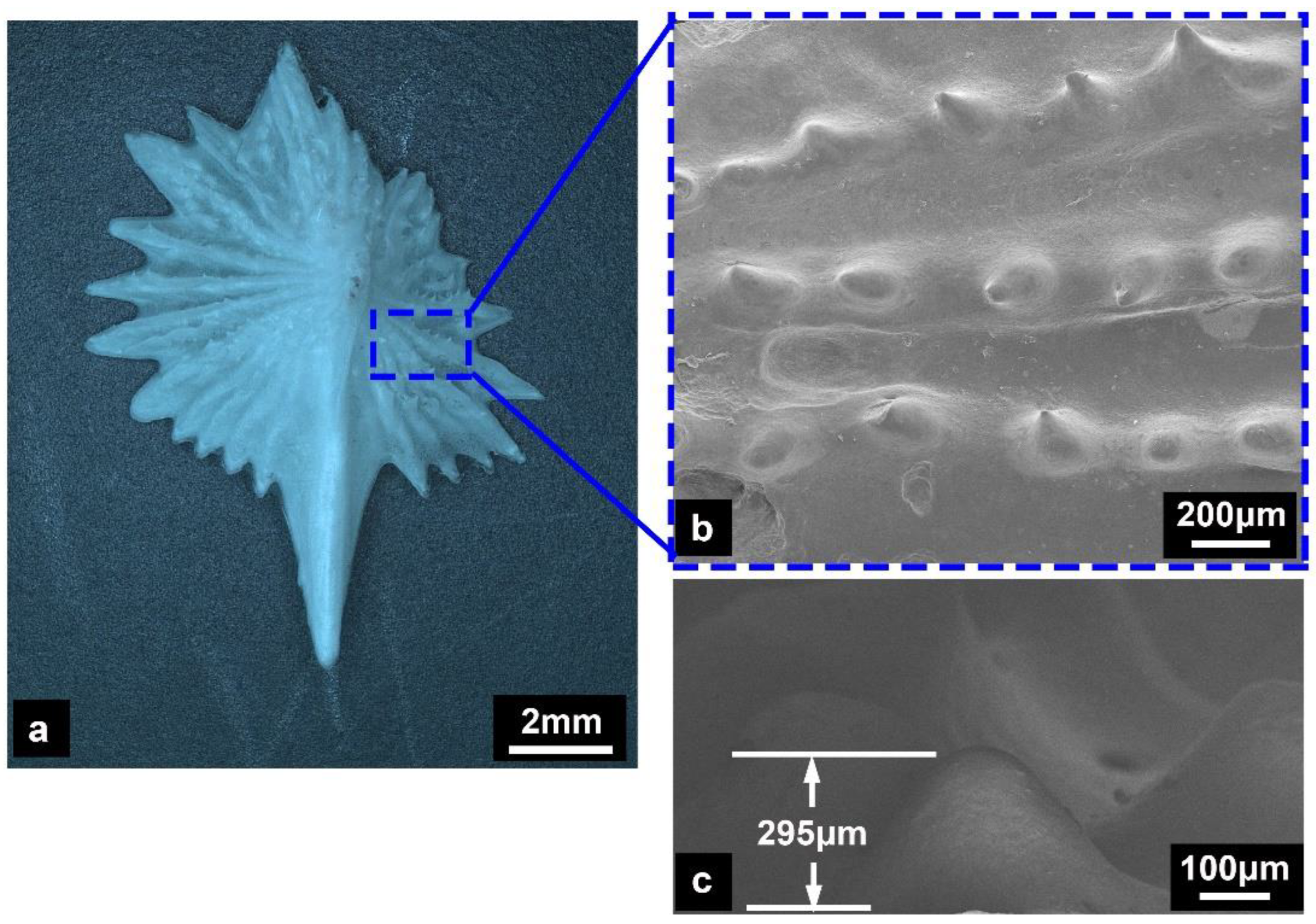

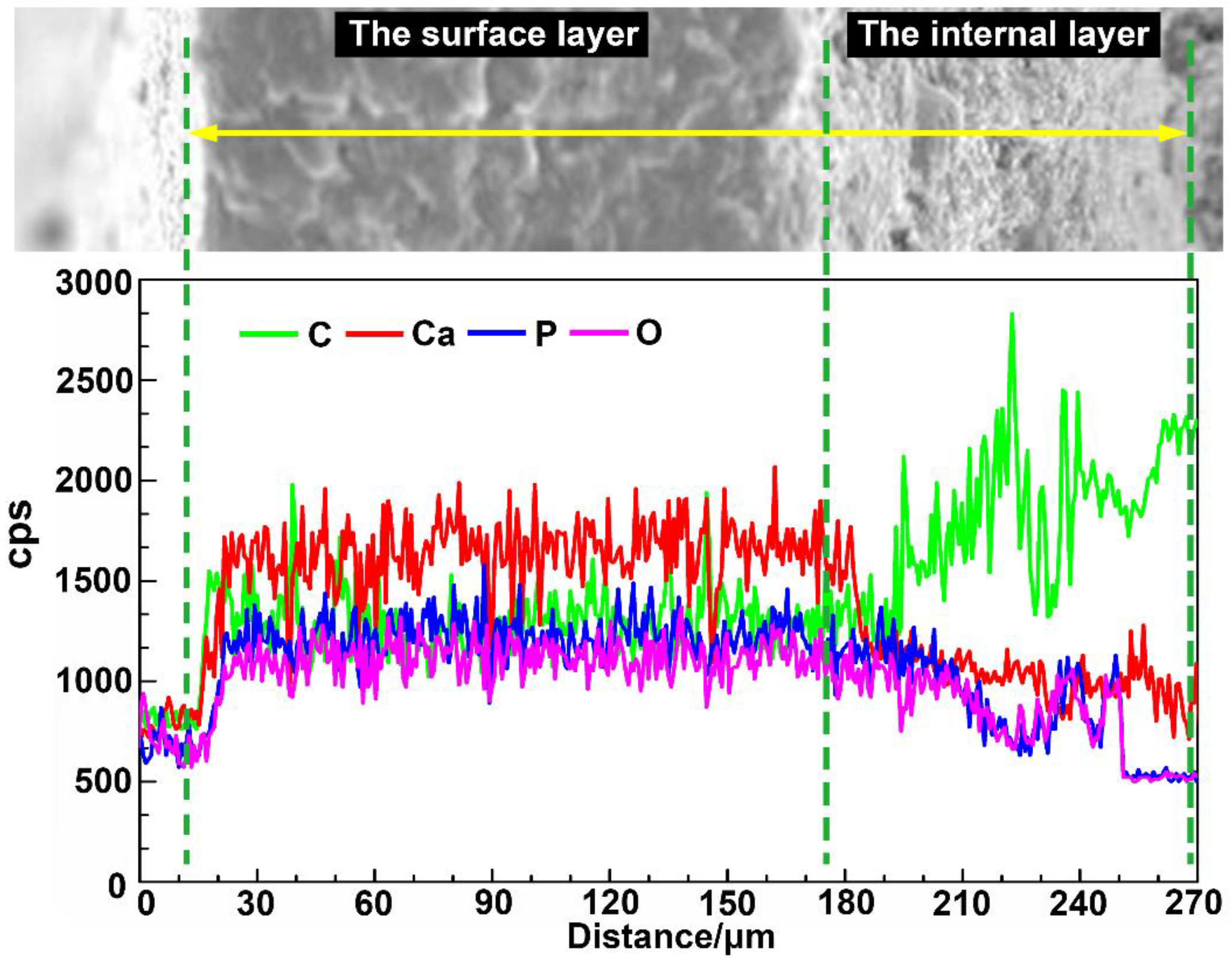



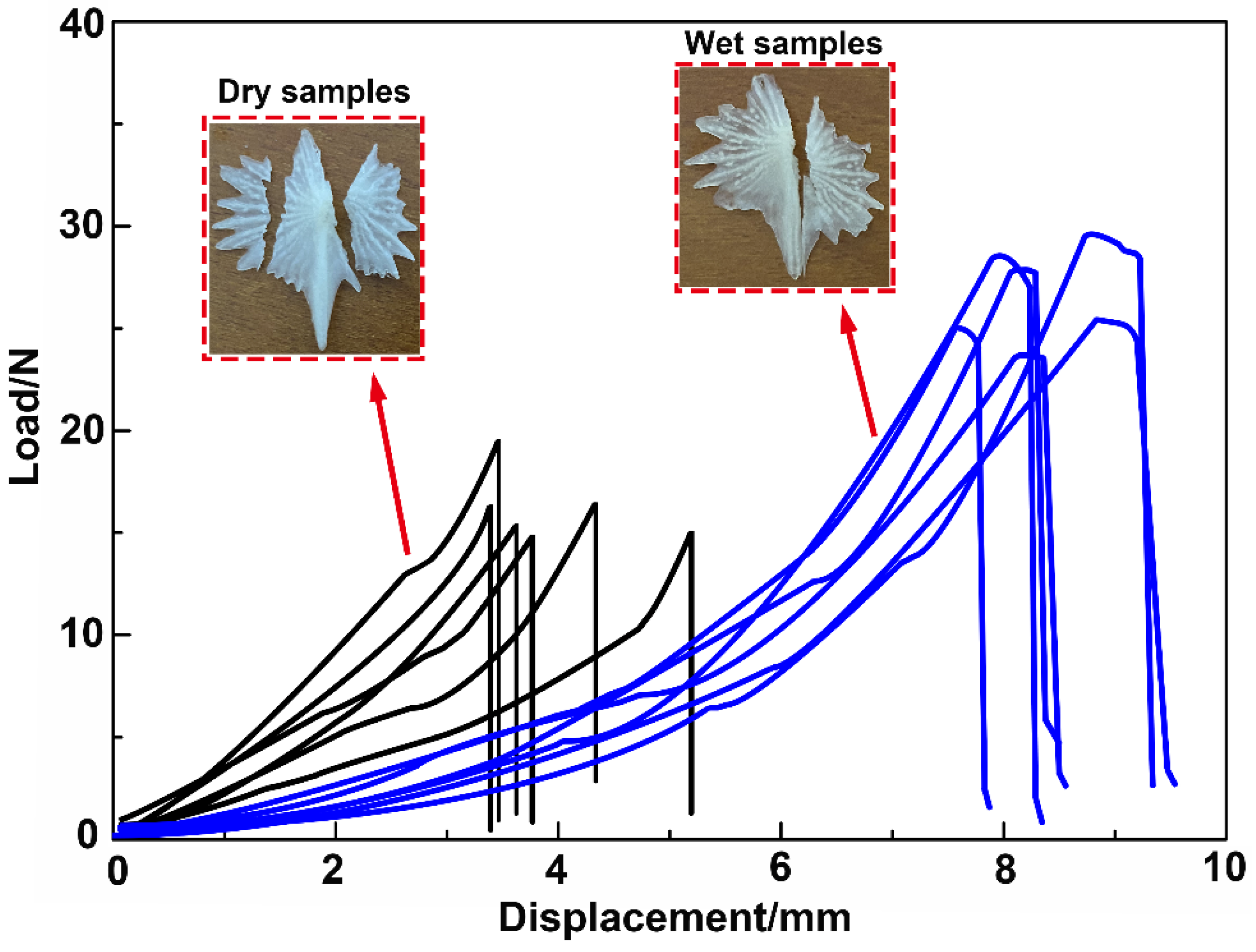
| Element | Surface Layer | Internal Layer |
|---|---|---|
| C | 25.32 | 35.59 |
| Ca | 31.55 | 25.41 |
| P | 19.58 | 16.52 |
| O | 18.75 | 16.63 |
| Sample | Layer | Modulus/GPa | Hardness/GPa |
|---|---|---|---|
| Dry | Surface layer | 11.85 ± 0.63 | 0.29 ± 0.05 |
| Internal layer | 10.88 ± 0.78 | 0.26 ± 0.04 | |
| Wet | Surface layer | 8.69 ± 0.67 | 0.22 ± 0.04 |
| Internal layer | 7.74 ± 0.58 | 0.18 ± 0.03 |
| Dry Samples | Wet Samples | |
|---|---|---|
| Longitudinal tensile strength (MPa) | 136.23 ± 3.57 | 139.47 ± 4.26 |
| Transverse tensile strength (MPa) | 98.62 ± 3.43 | 100.57 ± 3.51 |
| Longitudinal specific tensile strength (kN·m/kg) | 46.19 ± 2.14 | 48.09 ± 2.27 |
| Transverse specific tensile strength (kN·m/kg) | 32.26 ± 2.22 | 33.63 ± 2.18 |
Disclaimer/Publisher’s Note: The statements, opinions and data contained in all publications are solely those of the individual author(s) and contributor(s) and not of MDPI and/or the editor(s). MDPI and/or the editor(s) disclaim responsibility for any injury to people or property resulting from any ideas, methods, instructions or products referred to in the content. |
© 2023 by the authors. Licensee MDPI, Basel, Switzerland. This article is an open access article distributed under the terms and conditions of the Creative Commons Attribution (CC BY) license (https://creativecommons.org/licenses/by/4.0/).
Share and Cite
Zheng, Y.; Li, X.; Liu, P.; Chen, Y.; Guo, C. The Armor of the Chinese Sturgeon: A Study of the Microstructure and Mechanical Properties of the Ventral Bony Plates. Micromachines 2023, 14, 256. https://doi.org/10.3390/mi14020256
Zheng Y, Li X, Liu P, Chen Y, Guo C. The Armor of the Chinese Sturgeon: A Study of the Microstructure and Mechanical Properties of the Ventral Bony Plates. Micromachines. 2023; 14(2):256. https://doi.org/10.3390/mi14020256
Chicago/Turabian StyleZheng, Yu, Xin Li, Ping Liu, Ying Chen, and Ce Guo. 2023. "The Armor of the Chinese Sturgeon: A Study of the Microstructure and Mechanical Properties of the Ventral Bony Plates" Micromachines 14, no. 2: 256. https://doi.org/10.3390/mi14020256






